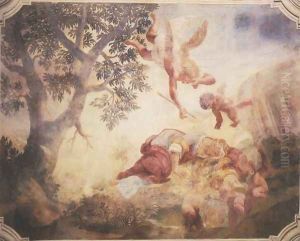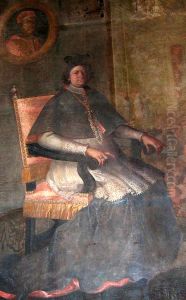Michelangelo Palloni Paintings
Michelangelo Palloni was an Italian painter of the Baroque period, known for his significant contributions to the art world, particularly in Poland, where he spent a considerable part of his career. Born in 1637 in Rome or Bologna, Italy, Palloni emerged from a cultural environment rich in artistic tradition. The Baroque era, characterized by its dramatic use of light and shadow, as well as its emphasis on emotion and naturalism, profoundly influenced his artistic development.
Palloni's journey as an artist began in Italy, but his reputation and skills led him to Poland, a country that became his second home. In the late 17th century, he moved to Poland at the invitation of the influential Sapieha family, who were prominent patrons of the arts. This move marked the beginning of an illustrious career that would leave a lasting impact on the Polish art scene. Palloni is best known for his frescoes and altar pieces, which adorn many of Poland's churches and palaces. His works are celebrated for their vibrant colors, dynamic compositions, and the skillful incorporation of Baroque aesthetics.
Among Palloni’s notable works are the frescoes in the churches of St. Kazimierz and St. Teresa in Vilnius, which today is the capital of Lithuania. These masterpieces showcase his ability to blend spiritual themes with the grandiose style of the Baroque period. His work in the Sapieha chapel of the Dominican Church and the frescoes in the Branicki Palace in Białystok are other exemplary instances of his artistry. Palloni was adept at creating compositions that were not only visually stunning but also deeply reflective of the spiritual and philosophical currents of his time.
Michelangelo Palloni's legacy is not limited to his contributions to the art of painting; he is also remembered for his role in mentoring the next generation of artists. Through his work and teaching, he helped to propagate the Baroque style in Central and Eastern Europe, influencing local artists and shaping the region’s artistic landscape. Palloni passed away in 1712, but his works continue to be admired for their beauty and historical significance. Through his creative genius, Palloni bridged Italian Baroque influences with Northern European sensibilities, creating a unique fusion that enriched the cultural heritage of Poland and beyond.

